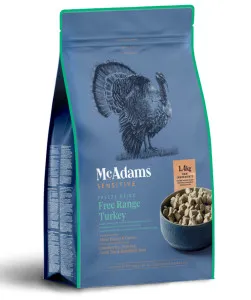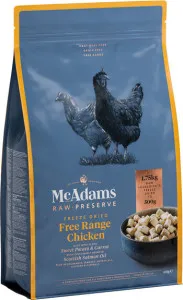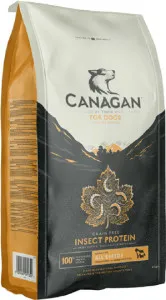Is Grain-Free Food Really Better for Dogs?
Grain-free dog food has become a hot topic among pet owners, with many believing it’s a healthier choice for their furry friends. But is grain-free food really better for dogs, or is it just another pet food trend? Let’s dive into the facts, myths, and expert opinions to help you make an informed decision.
What Is Grain-Free Dog Food?
Grain-free dog food is exactly what it sounds like—dog food that excludes grains like wheat, corn, rice, and barley. Instead, these formulas use alternative carbohydrate sources such as:
- Sweet potatoes
- Peas
- Lentils
- Chickpeas
- Potatoes
- May help dogs with grain allergies: Though rare, some dogs do have sensitivities to grains.
- Higher protein content: Many grain-free formulas use more meat-based proteins.
- Alternative carbs: Sweet potatoes and peas provide fiber and nutrients.
- Weight management: Some grain-free diets are lower in calories.
- Potential link to heart disease: The FDA has investigated a possible connection between grain-free diets and dilated cardiomyopathy (DCM).
- Higher cost: Grain-free food is often more expensive than traditional kibble.
- Unbalanced nutrition: Some grain-free brands skimp on essential nutrients.
- Overhyped benefits: Many dogs don’t need a grain-free diet to thrive.
- Essential carbohydrates for energy
- Fiber for digestion
- Vitamins and minerals
- Healthy fats
- High-quality protein: Look for real meat as the first ingredient.
- Complete nutrition: Ensure the food meets AAFCO standards.
- Your dog’s age and health: Puppies, seniors, and dogs with medical conditions have different dietary needs.
- Vet recommendations: Always consult your vet before switching diets.
- Your dog has a confirmed grain allergy (diagnosed by a vet).
- Your vet recommends it for a specific health condition.
- Your dog thrives better on a grain-free diet (monitored by a professional).
Many pet owners opt for grain-free diets because they believe grains are fillers or allergens. But is this really the case? Let’s explore further.
The Rise of Grain-Free Dog Food
Grain-free dog food gained popularity due to the increasing demand for "natural" and "ancestral" diets. Many brands market grain-free options as being closer to what dogs would eat in the wild, even though domestic dogs have evolved to digest grains over thousands of years.
Another reason for the trend is the belief that grain-free food helps with allergies. While some dogs do have grain allergies, they’re actually quite rare. Most food allergies in dogs are linked to proteins like beef, chicken, or dairy—not grains.
Pros of Grain-Free Dog Food
While grain-free food isn’t necessary for every dog, there are some potential benefits:
However, these benefits don’t apply to all dogs, and grain-free food isn’t inherently superior.
Cons of Grain-Free Dog Food
Despite its popularity, grain-free dog food has some downsides:
The DCM Controversy
One of the biggest concerns about grain-free dog food is its potential link to DCM, a serious heart condition. The FDA has reported cases of dogs developing DCM after eating grain-free diets high in legumes or potatoes. While research is ongoing, some vets recommend caution when feeding grain-free food unless medically necessary.
Recommended Products

McAdams Freeze Dried Free Range Turkey is an excellent choice for is grain free food really better for dogs?. This dog food contains Boneless Free Range Turkey 86.5% and other high-quality ingredients that promote overall health.

McAdams Freeze Dried Free Range Chicken is an excellent choice for is grain free food really better for dogs?. This dog food contains Boneless Free Range Chicken 86% and other high-quality ingredients that promote overall health.

Canagan Insect is an excellent choice for is grain free food really better for dogs?. This dog food contains Freshly Prepared Insects (27%)* and other high-quality ingredients that promote overall health.
Do Dogs Need Grains?
Contrary to popular belief, most dogs digest grains just fine. Dogs have evolved alongside humans for thousands of years, adapting to eat a variety of foods—including grains. High-quality grains like brown rice and oats provide:
Unless your dog has a diagnosed grain allergy, there’s no need to avoid grains.
How to Choose the Best Dog Food
Instead of focusing solely on grain-free vs. grain-inclusive, consider these factors when choosing dog food:
If you’re unsure, try our Pet Food Analyzer to compare different dog food options.
When Should You Consider Grain-Free Food?
Grain-free food may be beneficial in certain situations:
Otherwise, a balanced diet with high-quality grains is perfectly healthy for most dogs.
Final Thoughts: Is Grain-Free Better?
The answer isn’t black and white. Grain-free dog food isn’t inherently better—it depends on your dog’s individual needs. While some dogs benefit from grain-free diets, most do just fine with grains. The key is choosing a high-quality, nutritionally balanced food that suits your dog’s health, age, and activity level.
Before making any changes to your dog’s diet, consult your veterinarian. And if you’re looking for personalized recommendations, check out our Pet Food Analyzer to find the best food for your pup.
